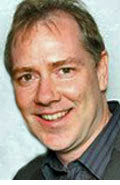Former student helps design kinetic installation for MSC

Andrew Vrana
A high-tech, permanent installation in the [Memorial Student Center] (http://ourmsc.tamu.edu/) portraying Texas A&M students past and present, designed in part by a former environmental design student, was activated by university president R. Bowen Loftin during a ceremony Friday, Feb. 22, 2013.
“Memory Cloud,” a hanging sculpture consisting of 4,000 individually controlled LED nodes embedded within transparent tubes of various lengths that will display 3-D silhouettes in real time and from days past, was designed by Andrew Vrana ’93, a principal partner at [METALAB] (http://www.metalabstudio.com/) , with collaborators from his firm and [RE:site] (http://resitestudio.com/) , a practice specializing in architectural installations.
Dr. R. Bowen Loftin, president of Texas A&M and Dr. Richard Box, chairman of the Texas A&M University System, board of regents, praised “Memory Cloud” during an unveiling ceremony at the J. Wayne Stark Galleries, adjacent to the installation site.
After Loftin activated the piece from an iPad, silhouetted animations from a 2012 Aggie football game were displayed on the installation, including moving images of the Fightin' Texas Aggie Band, fans in the Kyle Field stands and Heisman Trophy winning quarterback Johnny Manziel.
Vrana said the installation will provide a process of discovery for some students, because, depending on where a viewer is in relation to “Memory Cloud,” one might see the 3-D images of Aggies past and present or abstract patterns of pulsing lights.
“A lot of students just blow right by civic art,” he said. “I’ve thought to myself that if I ever got an opportunity, I would create something that engages and reflects the community. That was a driving rationale in the piece’s design.”
Vrana said a possible scenario would include a freshman walking past “Memory Cloud” outside the MSC at night, glancing at the installation and thinking he sees a piece featuring randomly pulsing LEDs.
“Later, he might get a glimpse of human forms, and then realize these are fellow students from the present and the past,” he said, explaining his concept of self-discovery in civic art.
The installation, said Lee, is an example of what’s possible with programmable LEDs, remote sensing, parametric design and digital fabrication.
“I think it’ll be a real landmark piece,” he said.
“Memory Cloud” was chosen as the winner among three finalists in the MSC’s Sculpture Commission Competition, sponsored by the [University Art Galleries Department] (http://uart.tamu.edu/) ; the $350,000 commission was awarded in February 2012.
In the competition, professional artists were asked to submit proposals in any style, medium or theme. Artists were asked to review the architectural design of the building and create a proposal that fostered the vision of the MSC as a vibrant and welcoming place for students and to reflect the MSC’s role as the gateway to campus.
In the project’s design stage, Vrana and his collaborators developed a virtual model with variable inputs allowing them to shape the proposal with material and budgetary constraints in mind.
“We will use the same modeling process to develop the canopy and LED lighting system as a kit of parts that will be cut with a CNC router and pre-assembled prior to installation,” he said.
Vrana mentioned two late professors, [Alan Stacell] (http://archone.tamu.edu/college/news/newsletters/spring2008/stories/StacellMemorialDismantled.html) and [Paolo Barucchieri] (http://one.arch.tamu.edu/news/2012/4/10/barucchieri-passes-away/) , as significant influences in his development.
“Stacell taught conceptual structures, where we experimented with intuitive design and alternatives to thinking about space and making buildings,” he said. The second of two [towers] (http://archone.tamu.edu/college/news/newsletters/fall2009/stories/stacell_tower.html) honoring Stacell’s memory, built in 2009, stands in the Langford Architecture Center atrium. “Barucchieri was also a great mentor,” said Vrana. “He helped me discover the timeless relationship between art, architecture and media.”
Tags
Related Posts

Former student’s MSC installation debuts in late 2012

Pixar Viz alumnus enlightens students with technical skills

13 outstanding alums share how college aided their success

Viz alumna says collaboration skills handy at Pixar

Student’s photos on display at Stark galleries in July
Follow Us
Facebook Twitter Vimeo Youtube Flickr RSS
Recent Posts

Planning prof heads study of disaster housing aid

A message from the dean

Former student remembered as expert planner

Leading educator named new head of Architecture Dept.








_thumbnail_small.png)
